by GaryG
Repeat after me: it’s all about the people!
It was on June 22, 2012 that I received a late-night email from my watch pal Terry suggesting that I take a close look at www.mingthein.com – the blog of photographer, business strategist, and watch enthusiast Ming Thein – if I hadn’t already.
I recalled Ming from various conversations on the PuristS watch forum but must confess that it wasn’t until that night that I became fully aware of his tremendous talents, and by the following day I’d enrolled as a student in his correspondence photography training program.
The hands of time spin forward with alarming speed! In the years since, Thein has taught me a great deal about photography and he somehow has also found the time to continue his own shooting and writing, take on an executive role at Hasselblad for a time, and, most relevant for us here, launch his eponymous watch brand in 2017.
It was with great interest (as a watch enthusiast) and some trepidation (as a humble student) that I took on the task of capturing a pre-production example of Ming’s latest, the Model 19.02 GMT.
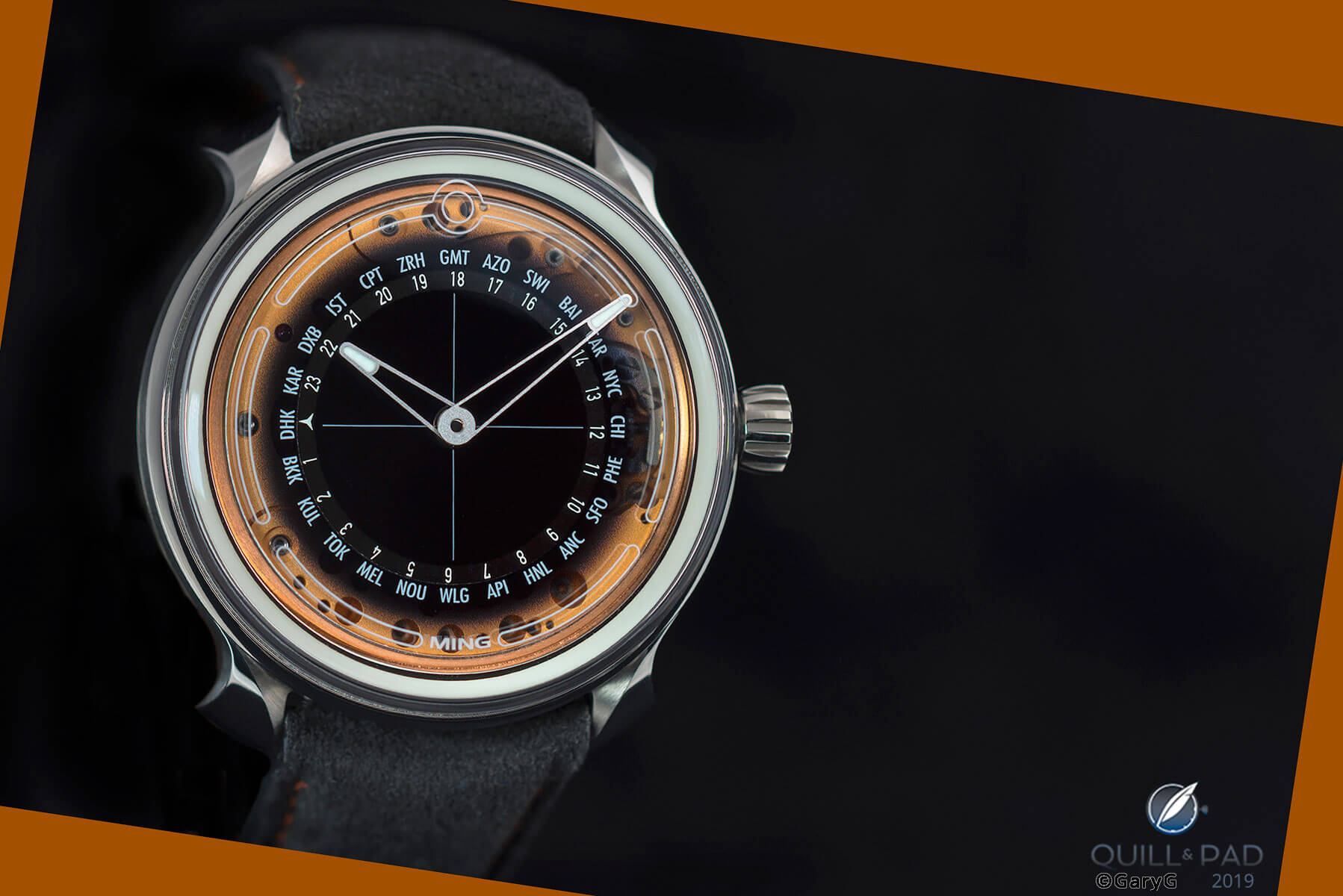
Polymath’s project: Model 19.02 by Ming
Ming Model 19.02: face first
Owners will spend most of their time with the 19.02 looking at the front of the watch and fully expect that will be an enjoyable experience!
While gradient tone dials are now a “thing” in the watch business, in most cases with which I’m familiar the color and tone are lightest at the center of the dial and gradually darken toward the edges. As on the prior Model 19.01 time-only watch, the 19.02 takes the opposite path with a dark center and gradual lightening toward the edges to reveal aspects of the gold-plated movement below.
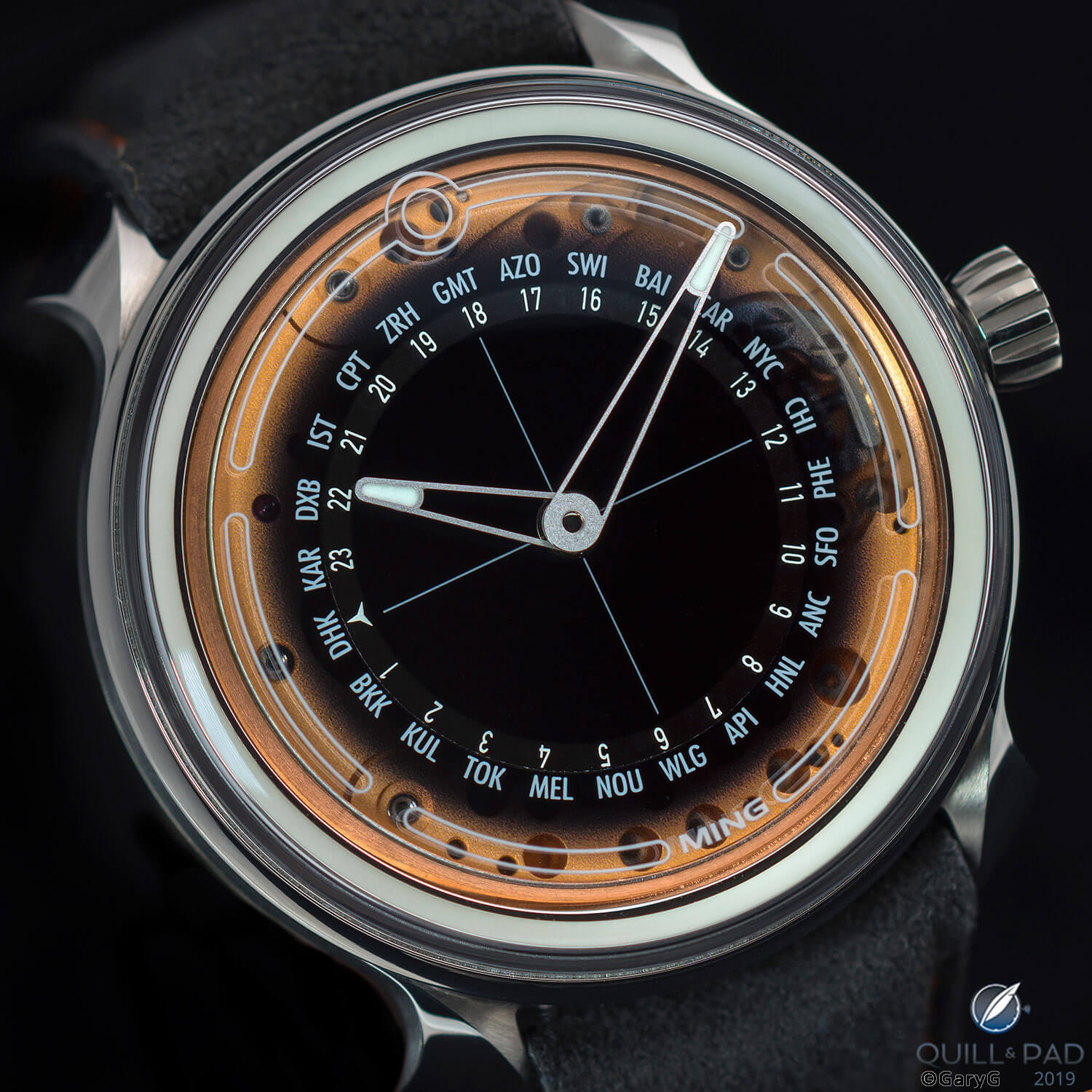
Gradient dial, Ming Model 19.02
In the first of many thoughtful (a word you’ll be seeing a lot here) touches, the printing of the city codes for the GMT indication and the black gradient coating is on the bottom side of the sapphire crystal dial disk to reduce the apparent vertical visual distance between the location and its corresponding time. The world times themselves are shown on a crown-set, rotating blackened titanium disk immediately below.
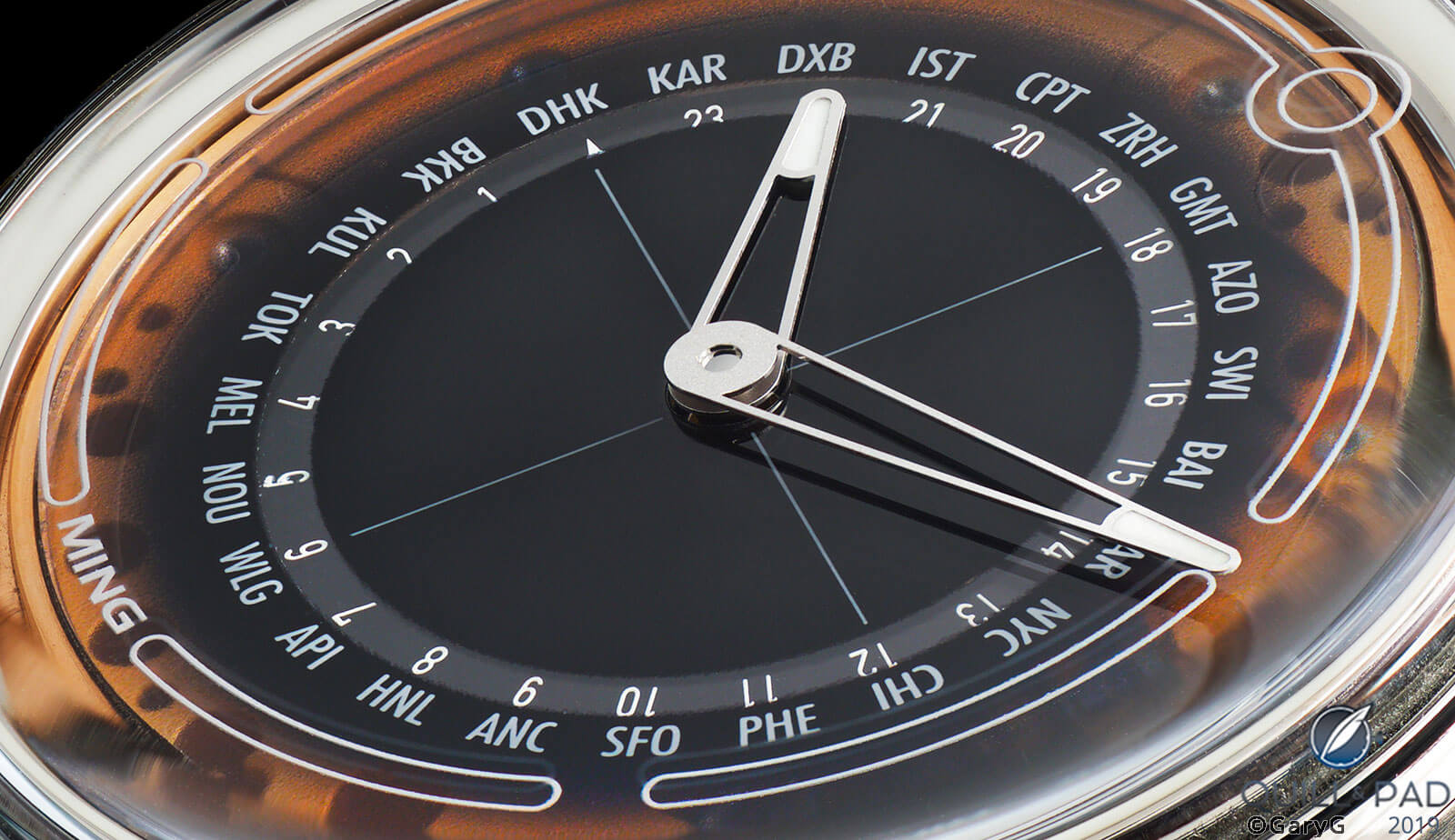
City and world time indications, Ming Model 19.02
The stylized zero at the top of the dial, virtual chapter ring with openings at the even hours, and brand signature are printed on the underside of the domed crystal, providing visual interest and a sense of depth on the front of the watch. And the open-centered, frosted-finish hands mirror the shapes of the chapter ring, provide some real pop, and are easy to read in a wide variety of lighting conditions.
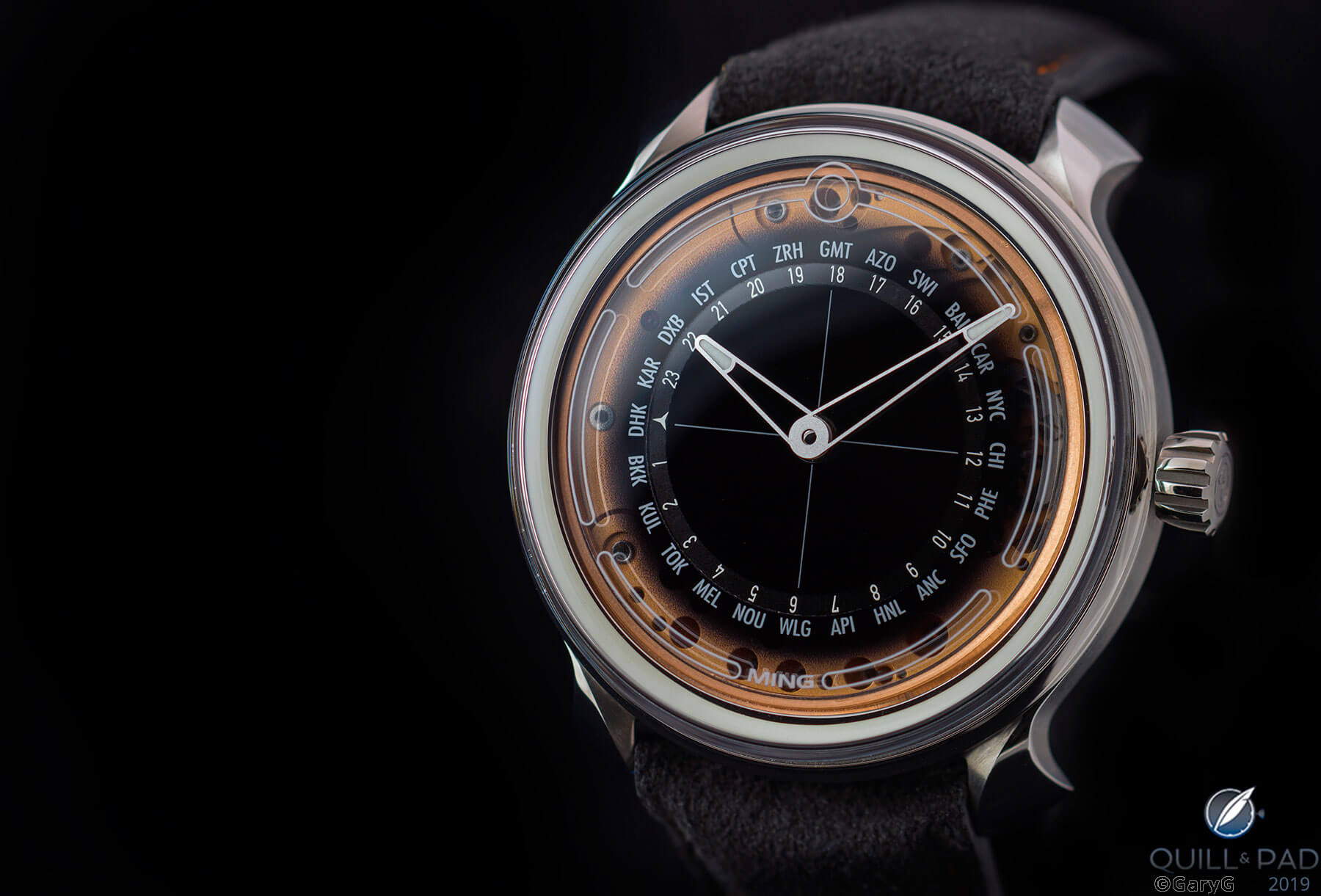
Visual interest and legible time: Ming Model 19.02
To know Thein is to appreciate how obsessive about detail a person can be, which in my view is an exceptionally positive personality trait to have if you are a watch creator – as long as you also have an eye for the whole and aren’t paralyzed by the desire for perfection. As an obsessive type myself, I was fascinated by the way that the under-crystal markings on this watch reflect from the sapphire crystal dial disk and then back and forth between the two disks in a seemingly endless sequence when seen from certain angles, suggesting (at least to me) the repetitive nature of compulsive thought.
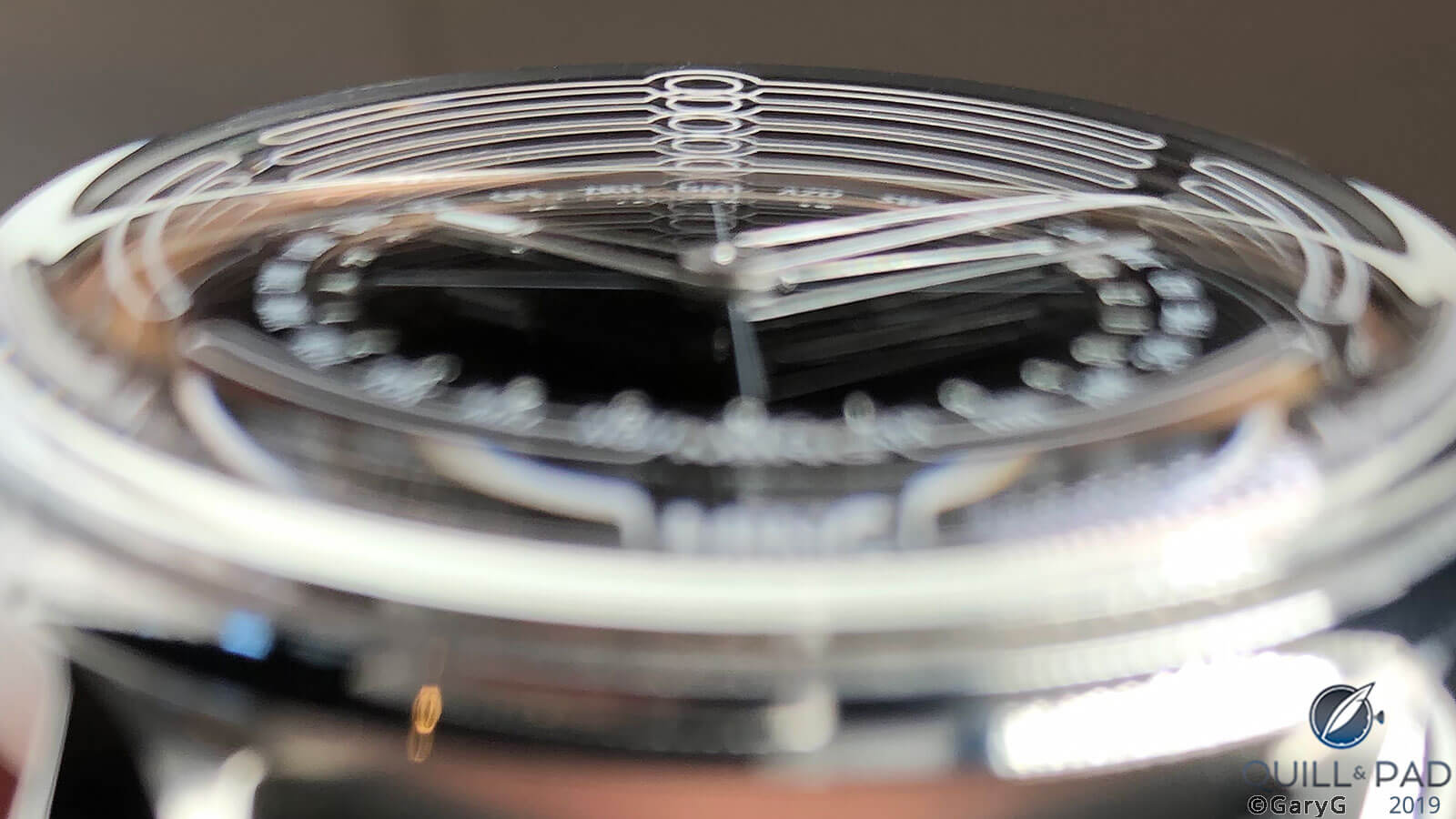
Turtles all the way down: recursive reflections, Ming Model 19.02
When you go from light to dark conditions, there’s a bit of surprise as the ring that surrounds the dial (and that to my eye blended innocently into the thin bezel) is luminous, complementing the tips of the hour and minute hands.
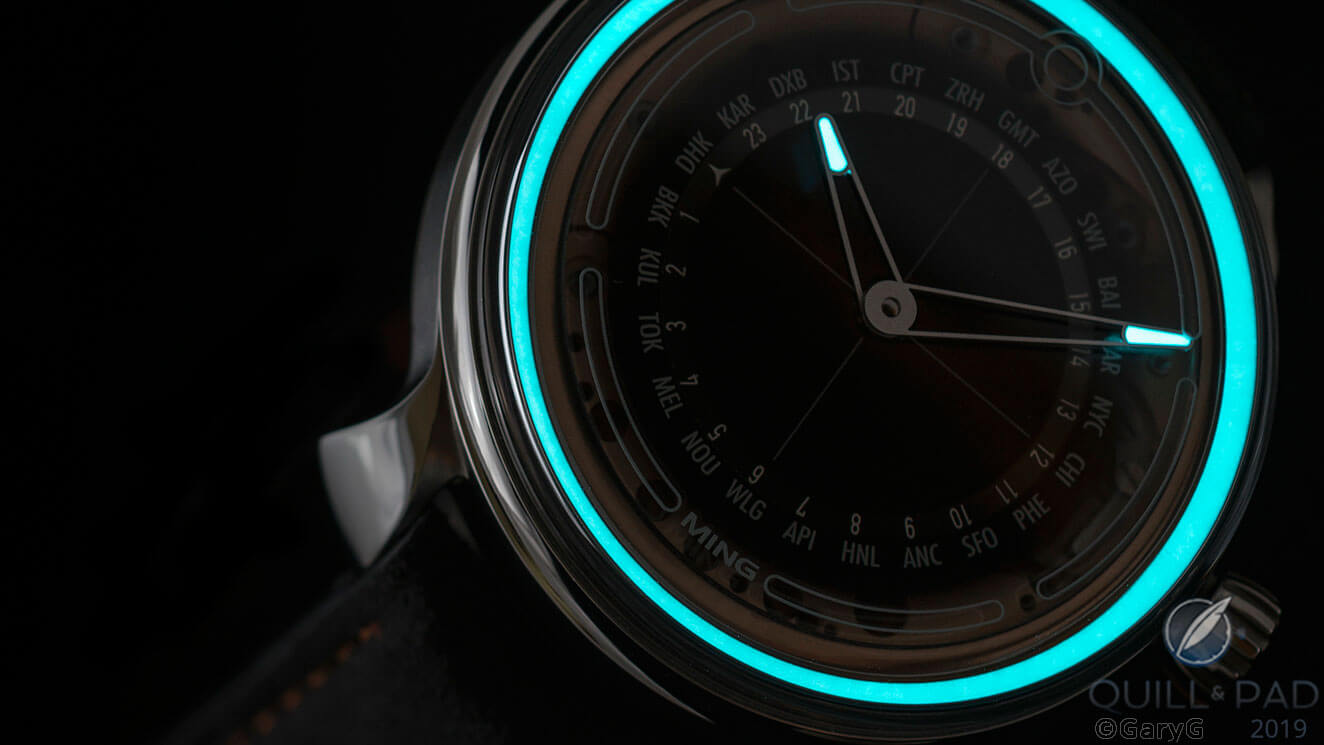
Luminous elements, Ming Model 19.02
Just in case
The emphases on visual interest and thoughtful touches continue with the 19.02’s case. Box sapphire crystals front and back sandwich a titanium center that employs alternating brushed and polished finishes, to my eye giving just the right balance of light-catching highlights against a more restrained main body.
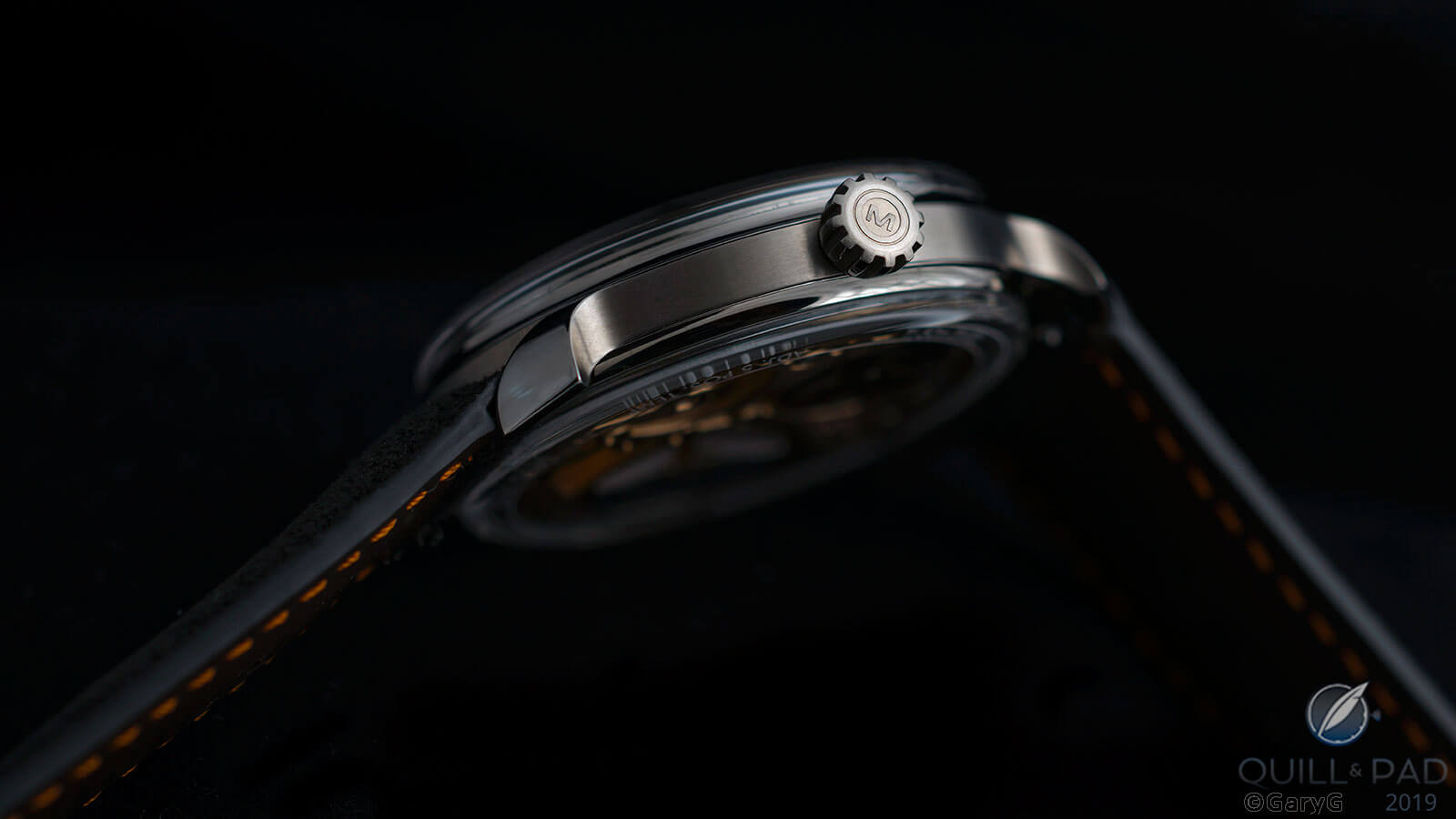
Balanced approach: brushed and polished titanium finishes, Ming Model 19.02
The crown you see in the image above is also very much to my liking: grippy and resolutely functional, yet coherent with the other elements of the design. And thought has clearly gone into the selection of the robust Jean Rousseau Paris straps provided with the watch, their accompanying curved quick-release spring bars, and the straightforward design of the signed stainless-steel buckle.
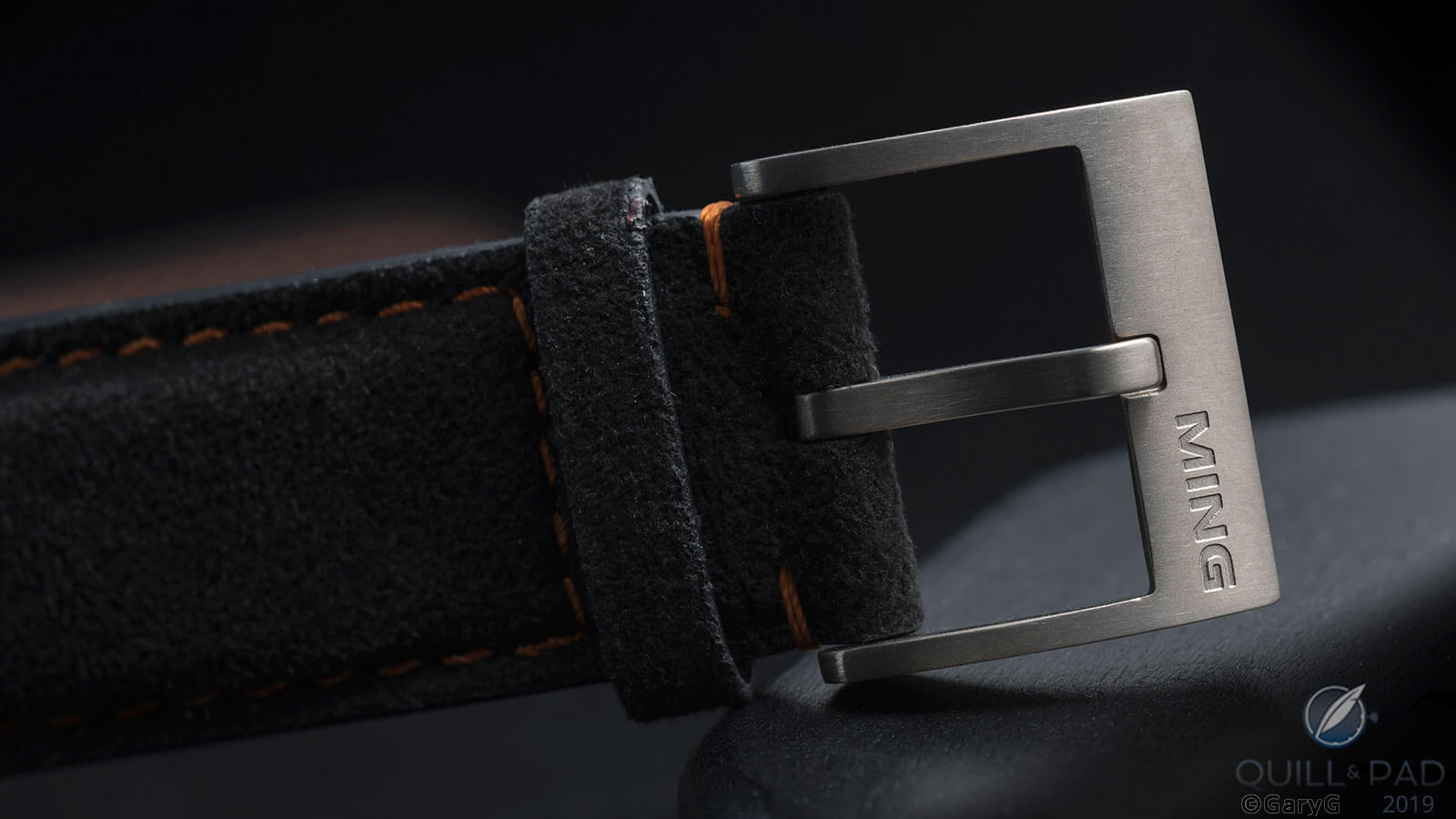
Buckle and strap detail, Ming Model 19.02
A design element that is easy to enjoy but devilishly difficult to capture in images is the lugs. I really like their distinctive shapes and especially enjoyed the visual transition from polished to brushed surfaces – but had to get out my loupe to understand how that visual magic is done.
As it turns out, there is actually a diagonal ridge across the upper surface of the lug, with the outer bright surface curving toward the wrist and the inner brushed surface curving down toward the strap and brushed case band. It might have been possible to give the same impression by simply brushing the inner area of a flat lug; for me, the extra thought, effort, and expense exerted to execute this more refined approach definitely merits mention.
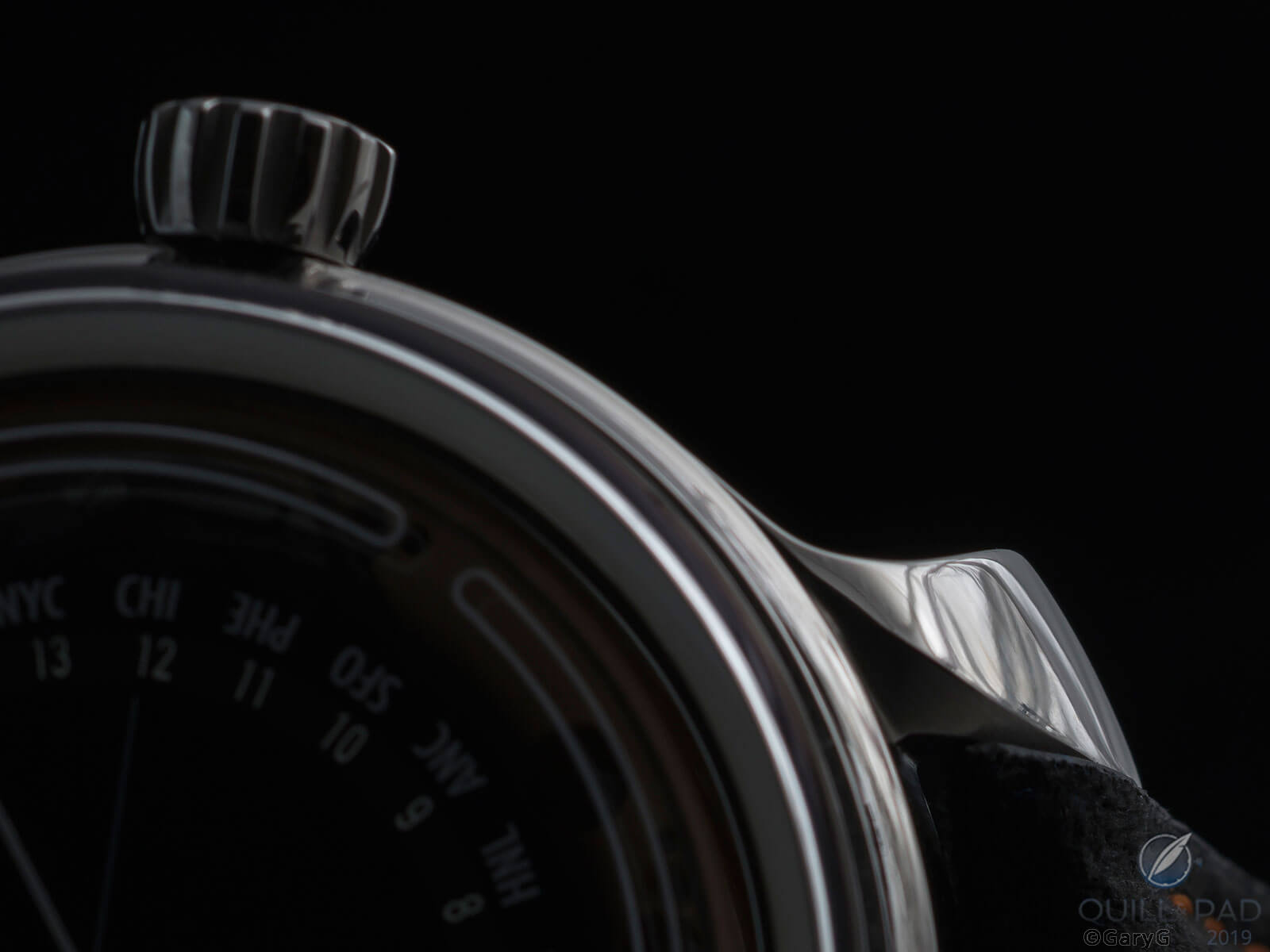
Case and lug detail, Ming Model 19.02
Moving right along
We’ve already seen part of the 19.02’s customized Schwarz Etienne Caliber ASE.220.1 movement through the clear portion of the dial but flipping the watch over leads to a real treat.
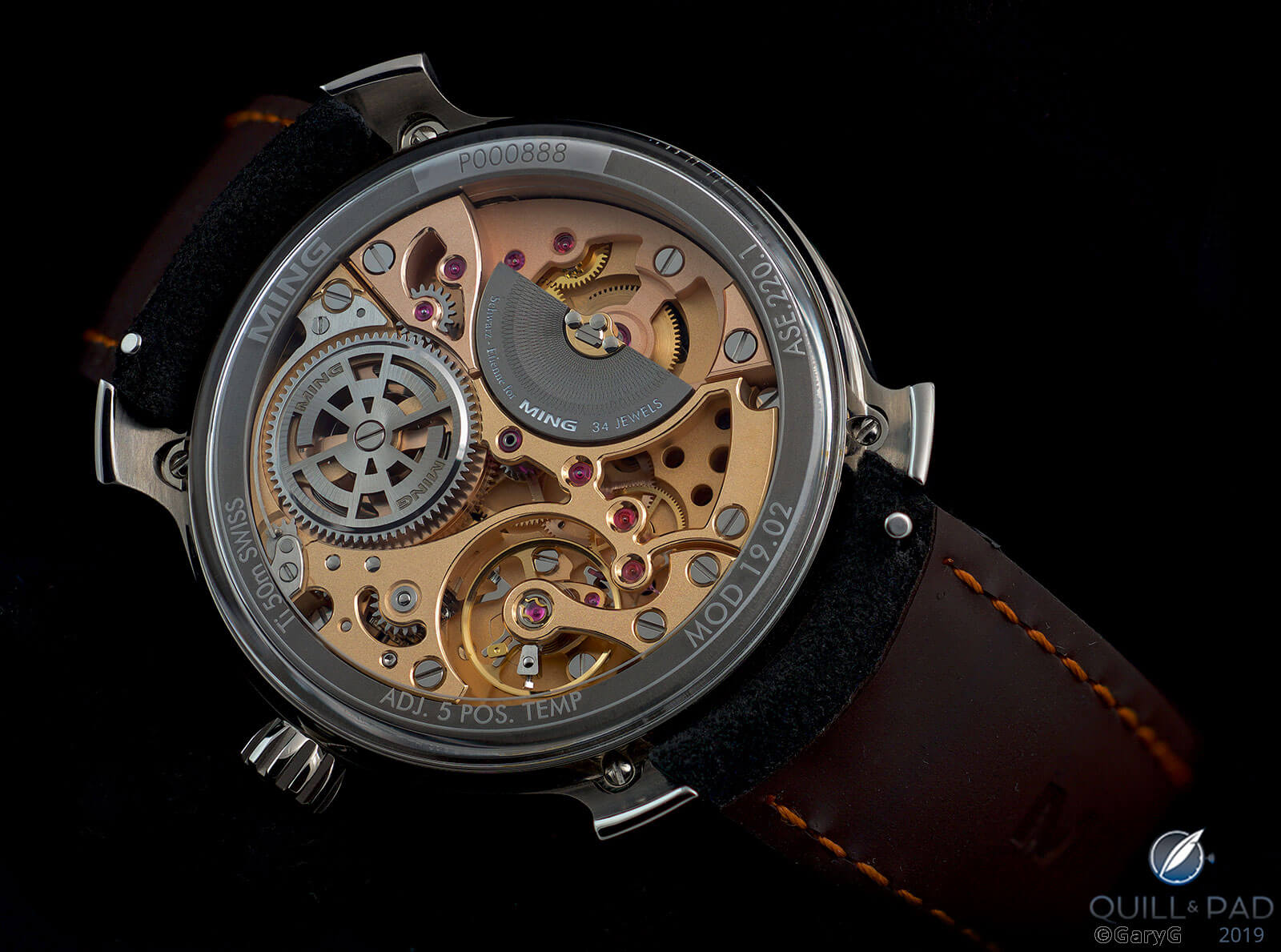
Caliber ASE.220.1 by Schwarz Etienne for Ming
As with the prior Model 19.01, Ming has gone with movement maker Schwarz Etienne as partner for the 19.02, and the result of that collaboration is really something. The starting Caliber ASE.220 micro-rotor movement has been opened out through partial skeletonization, bead-blasted and coated in 5N gold, and given a full complement of hand bevels and polished jewel sinks.
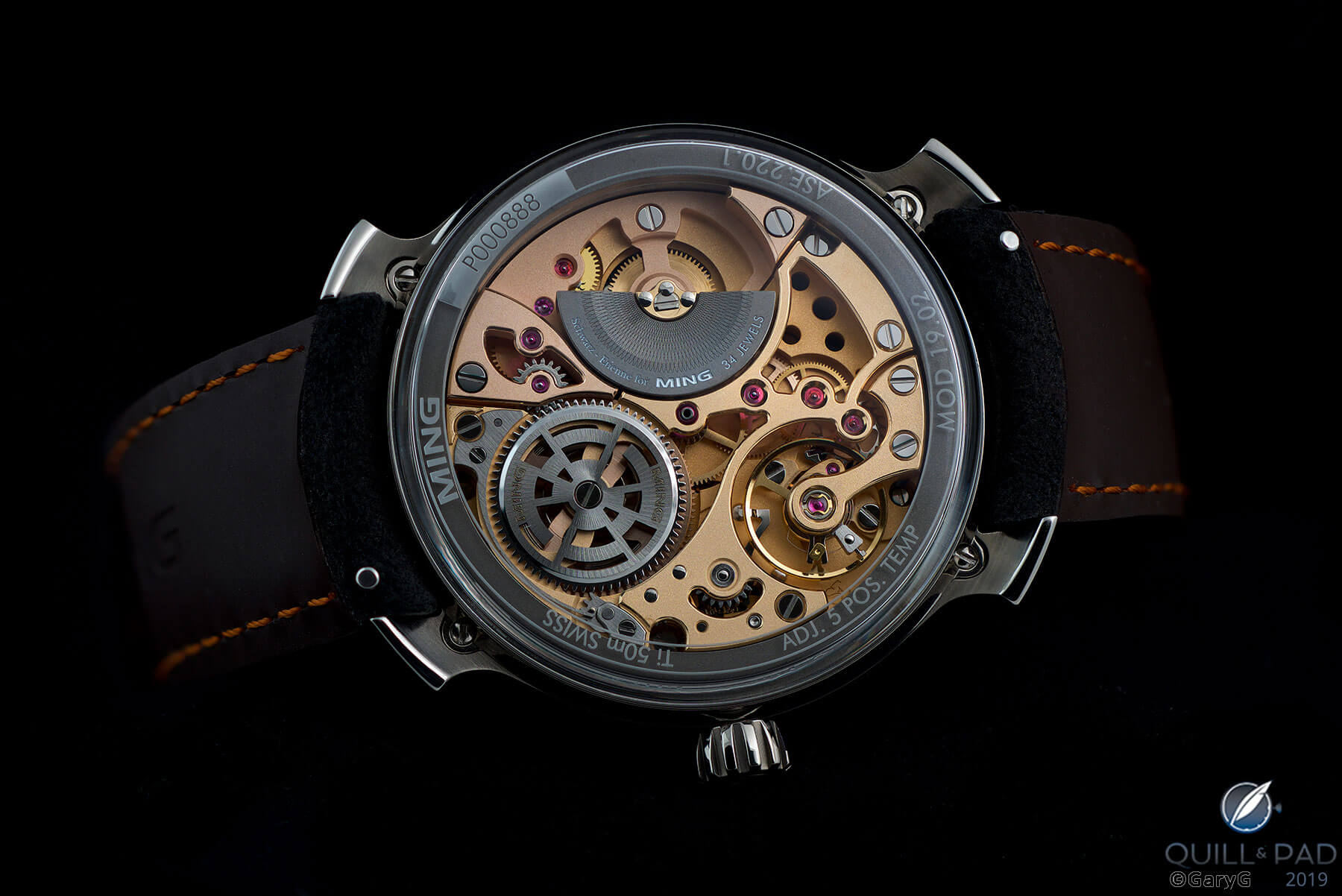
Three-sector design: Schwarz Etienne Caliber ASE.220.1
To my eye the movement divides nicely into three complementary sectors: barrel, winding, and balance, each with a circular focal point of slightly different size. There are just enough steel elements, including the maze-cut ratchet wheel and that tasty click spring, to catch the eye. And for me the radial brushing of the ratchet and more floral engraving on the tungsten rotor weight work together quite well.
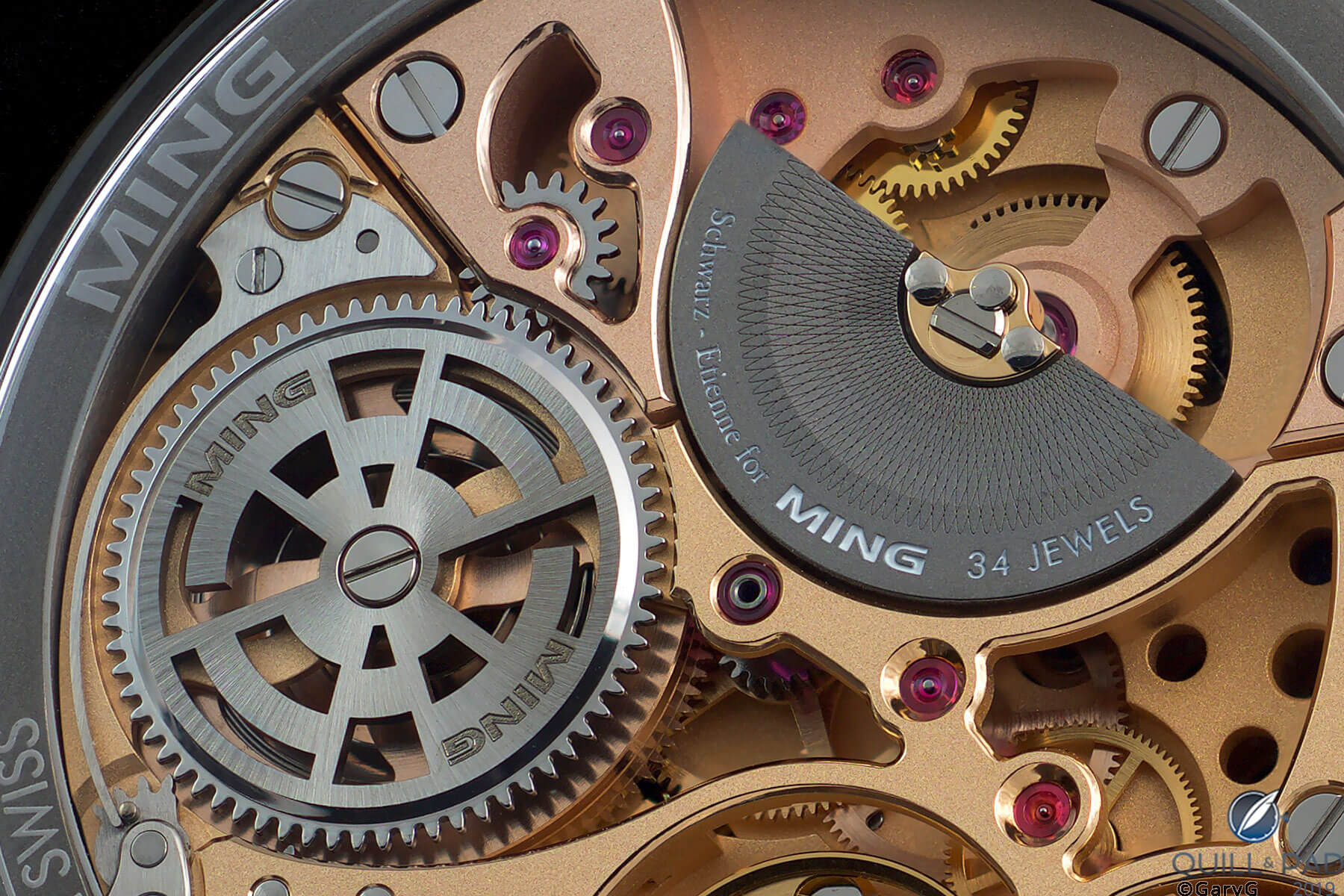
Complementary finishing details on the Schwarz Etienne Caliber ASE.220.1 for Ming
I had particular fun checking out (and photographing) this movement from an extremely low angle; seen from here, you can really get a sense of the depth of the movement and its individual elements, including that chunky rotor weight, and see how well the partial skeletonization works to reveal the movement’s inner workings.
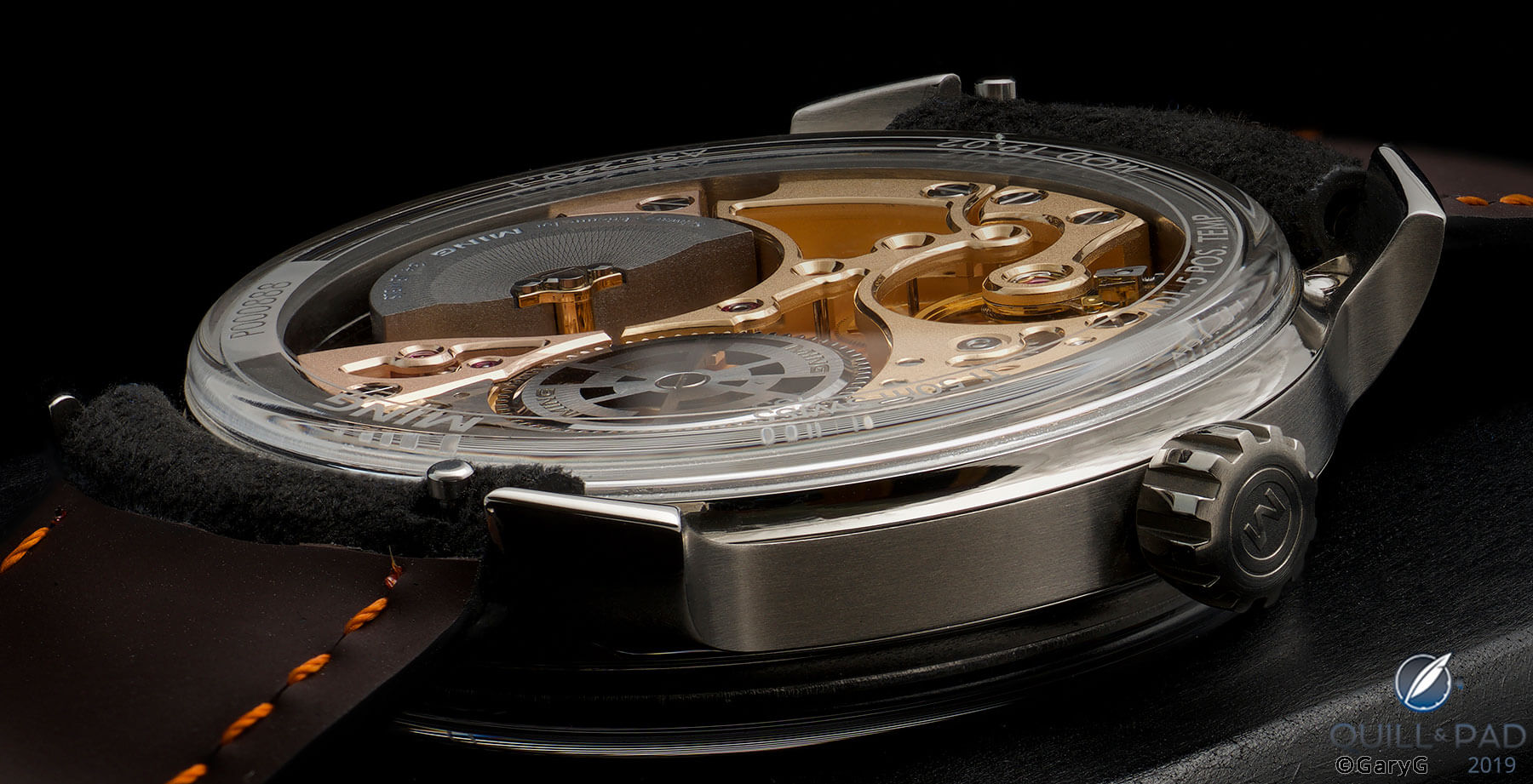
Snail’s eye view, Schwarz Etienne Caliber ASE.220.1
For photography fans out there, the image above is built up from a stack of 23 individual images, each with a separate focal depth and combined to allow for what his students call a “Ming sharp” result from edge to edge.
Ming Model 19.02: on the wrist
In photography, the starting point is light – looking for (or in the studio, creating) good light is the “wax on, wax off” starting point of productive shooting. With that in mind, I ventured out into my garden with the 19.02 on my wrist in search of a patch of sunlight filtering through the trees and found a watch-sized beam that allowed for a dramatic capture.
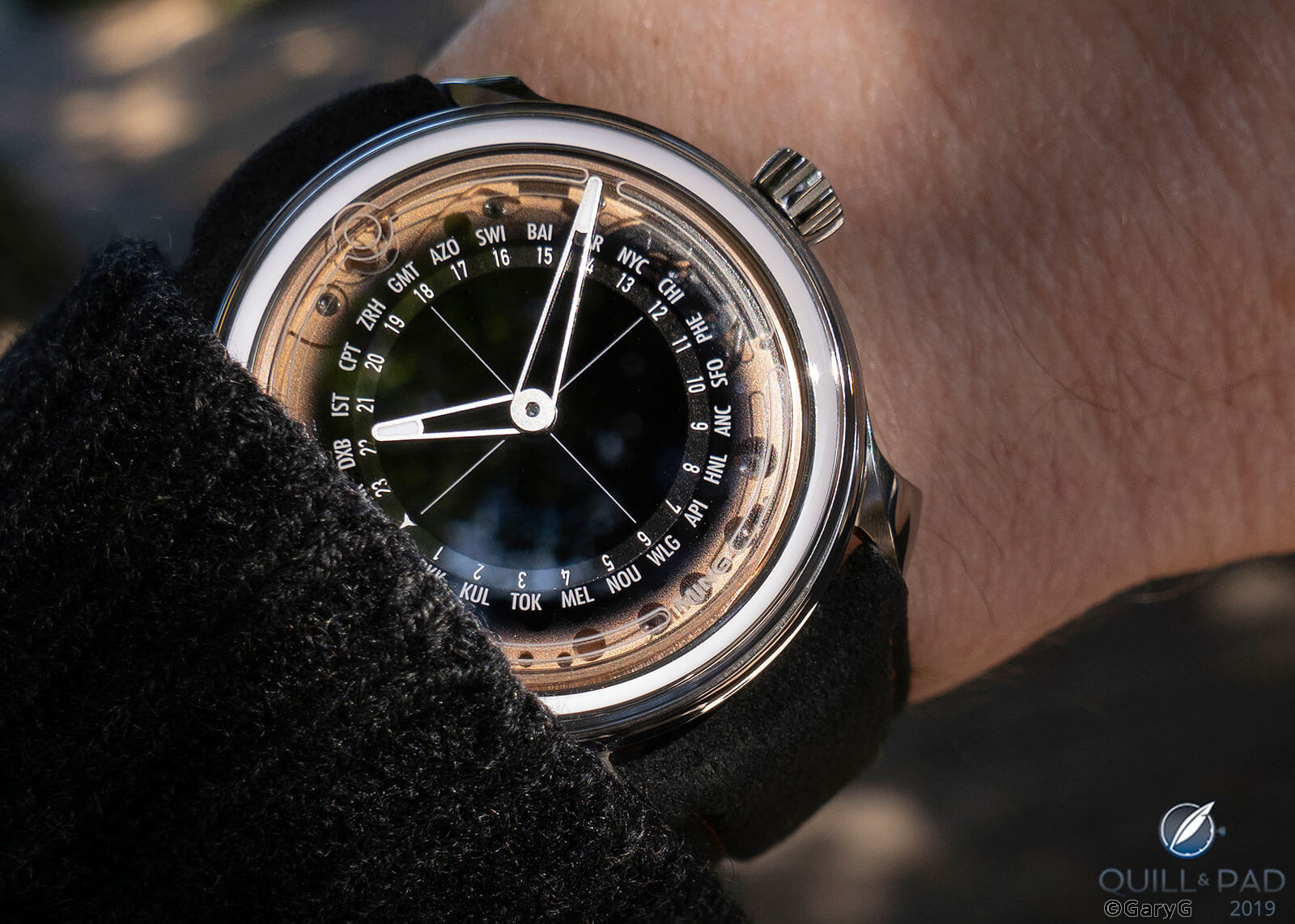
On the wrist: Ming Model 19.02
Ming Model 19.02: any quibbles?
As you can tell, I like this watch quite a bit! To the extent that I have reservations, they center on the piece’s world time display.
While I enjoy the fact that the Ming team selected cities for the time zones that were personal favorites of theirs (including my nearby city, San Francisco, and the brand’s home, Kuala Lumpur) there’s a bit of a challenge in the Mountain Time Zone with what I am guessing is an attempt to call out Phoenix, Arizona with the code PHE.
That might work for the constellation Phoenix, but I think the airport code (and common abbreviation) PHX might make more sense here. One additional problem with Phoenix is that it, along with much of the rest of the state of Arizona, does not observe Daylight Savings Time in the summer, so it’s actually on San Francisco time for a substantial chunk of the year.

Not a sight for old eyes: elegant but small world time display
A bigger issue for me is that with my aging eyes I have a tough time making out PHE, SFO, or any of the other city codes to try to use the world time indication. While the visual effect of the concentric displays of hour and location abbreviations is quite elegant, for me legibility – and therefore usability – suffers from their small size.
At some point, perhaps the Ming team will come out with a “geezer” edition of the Model 19.02 with larger fonts, fuller city names, and/or clearer delineation of day from night on the 24-hour time ring. Until then, I’m more drawn to 2018’s Grand Prix d’Horlogerie de Genève finalist, the time-only Model 19.01.
As usual, of course, your mileage may vary! If your visual acuity is better than mine, the convention that GMT is always at the top of the dial helps you to eyeball the time in that and other locations, or you’re willing to trade off super-easy reading in favor of striking visuals, in my view the Ming 19.02 could be just the right piece for you.
And given the excellent fit and finish of the “pre-production” watch I had the opportunity to photograph, there’s every reason to be confident in the quality of the finished product.
Whither Ming?
When I first encountered a Ming watch – the brand’s original Model 17.01, a time-only piece that sold for CHF 900 – I was inclined to characterize Ming as a micro brand, which to me is a term reflective of business model as much as of enterprise size. Specifically, for me key aspects of a micro brand are:
- A go-to-market model based on direct-to-consumer distribution, usually through online sales channels
- A funding model based on a subscription approach (such as crowdsourced advance deposits)
- A design-centric approach depending heavily on visual appeal to draw in buyers
- Utilization of purchased movements and outsourced production
- A clearly identifiable (and usually value-based) price level
Once you’ve established a core business model and brand perception, it can be quite tough to modify it; but clearly, this was Ming’s (and Thein’s) intent from the start. The 17.xx watches were great entry propositions, but the company’s product and market positioning roadmap has since gone straight upmarket to include the 19.xx models and others yet to come.
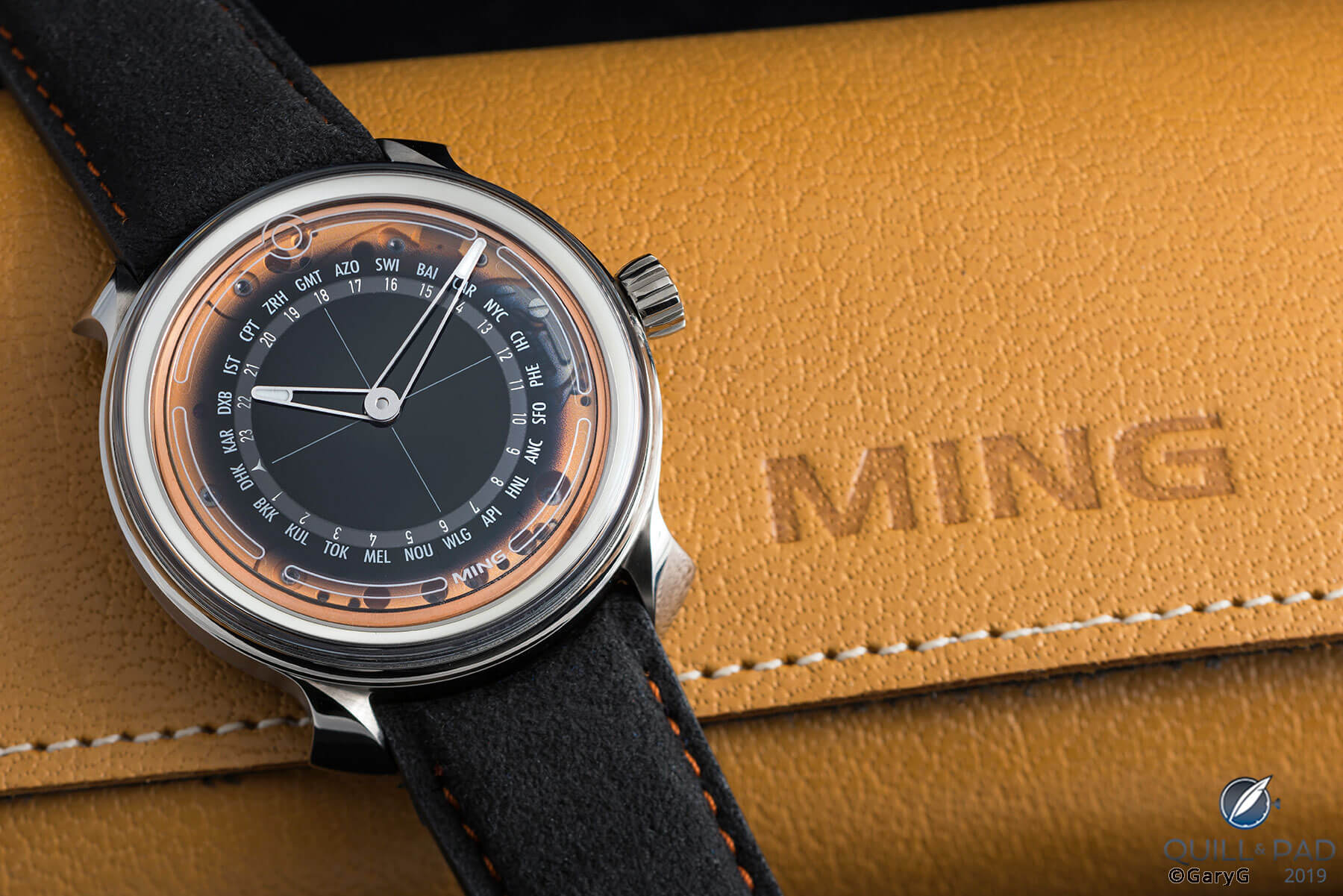
Going upmarket: Ming Model 19.02 with pre-production leather pouch (to be updated in final version)
So while I might originally have considered Ming as a more original alternative to brands such as Halios and Farer, at this point I don’t think it’s too crazy to project Ming’s future role as a direct-to-consumer analogue to MB&F: a design-centric, high-quality brand that stresses the contributions of a network of collaborators while being steered by a leader with a clear vision of what he wants to express and achieve.
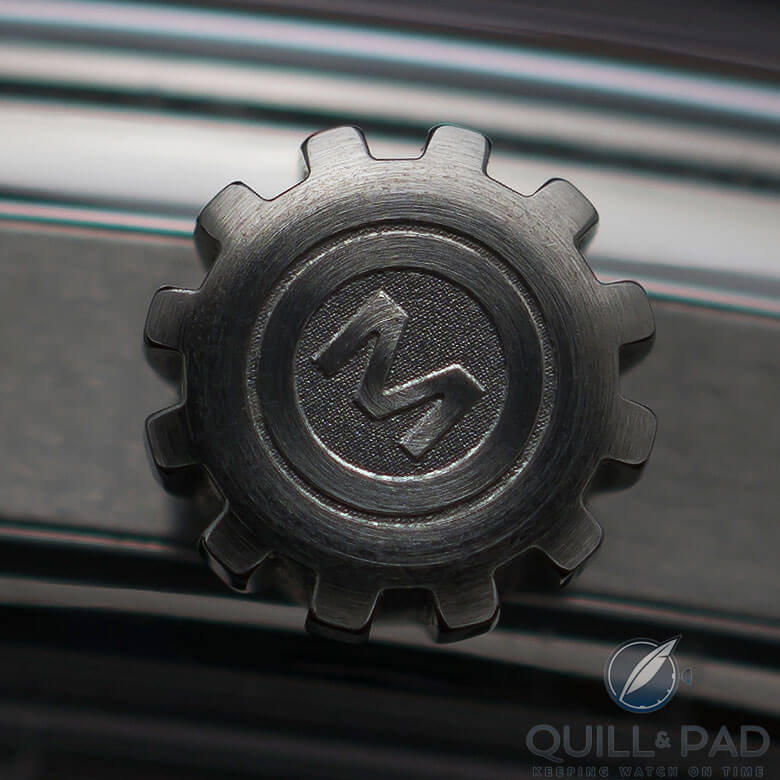
Parting shot: future watch empire? M for Ming on the crown of Model 19.02
Only time will tell if Ming can establish itself as an enduring institution on the watch scene, but if the brand can build on the thoughtfulness and attention to detail that have typified its offerings so far, in my view it certainly has a good chance of getting there.
For more information, please visit www.ming.watch/products/ming-19-02.
Quick Facts Ming Model 19.02
Case: 39 x 11.2 mm, grade 5 titanium; double box sapphire crystals with double-sided antireflective coating; 50m water resistance
Dial and hands: sapphire crystal dial with radial gradient from black to transparent; chapter ring, logo, and city markings laser-etched into the sapphire crystals and dial; hands and dial ring with Super-LumiNova X1
Movement: automatic Schwarz-Etienne for Ming Caliber ASE.220.1 with micro-rotor, customized with partial skeletonization, 5N coating, hand-polished anglage and bead-blasted bridges; 70-hour power reserve; 3 Hz/21,600 vph frequency; movement adjusted to five positions
Functions: hours, minutes; 24-hour world time
Price: CHF 11,900 through online purchase; CHF 10,900 bank wire price by request to Ming via email
Production: first shipments in 2019; new orders to ship from end of Q1 2020
You may also enjoy:
Ming 19.01 By Ming Thein, Unparalleled Quality For Price
Ming 17.03 GMT: A Brand On A Roll
Leave a Reply
Want to join the discussion?Feel free to contribute!





















































Great review, Gary! Though my main issue is the price of the 19.02, which is starting to creep higher than I would have guessed. According to their discussions of pricing for the 19.01, which was supposed to be the pinnacle of what could be expected from the brand, alluding to pricing for the 19.xx series being in the CHF 6-8K area max.
But at CHF 11-12K (a 50% price increase), now that watch seems rather affordable compared to this and nothing near the actually affordable 17.01 or 17.03, which was always under CHF 2K. And we have seen nothing of the 18.xx series, so at this point it feels like the roots of the brand are shriveling up and they are focusing much more upmarket. Of course this is fine and if that’s what sells then great. But I feel disheartened that what only a short time ago seemed like a brand I could really be into is now a brand that I couldn’t afford until the distant future when a $10K watch is a feasible thing to purchase.
The main selling point of the brand originally was value-based watches designed for collectors by collectors to inspire the joy of collecting watches that can actually be obtained by most collectors. But once you get past the $10K mark, and no advanced complications are present, we are just in the realm of small-quantity independents charging a premium for exclusivity. Again, that is fine and completely up to the brand, but I can’t help feeling that a bait-&-switch has been pulled and they are just out of reach again.
I used to love MING and what they were doing, and I still love the watches, but they have joined the realm of “Oh that’s really cool, I could never afford that, so dang… but hey, that’s really cool!” I wish them the best and I’m sure they have enough business to keep going, but if the next two or three watches aren’t under 4-5k, they are gonna lose a lot of fans and collectors that once again can’t afford the cool stuff. Which kind of defeats the stated purpose of MING in the first place.
Firstly, a huge thank you to Gary for the detailed thoughts and excellent images – I might have had some influence on your early photographic direction, but you are very much charting your own distinctive path now 🙂 And you are 100% right: it’s all about the people; without all of the friends I’d met over the past 18 years in this game, I wouldn’t have co-founders let alone any means to begin the journey.
To Joshua, if I may address your concerns directly: price and value are independent concepts. There are plenty of time only watches above $10k from the big brands (not even independents) that have the benefit of industrial scale and integrated production that also have no advanced complications. At the same time, I don’t think there are very many (if any) alternatives to the 19.02: where else do you get a long power reserve microrotor automatic world time with sapphire dial and hand bevelled/ polished anglage on a skeletonized top plate, with a largely unique movement at this price, or even double it?
Also, as a brand we are only in year two. We’ve launched four distinct models (of >75 designed to date) in that time and honestly – there are limits to how fast both we and the industry that supplies us can move to fill out the gaps. Some things take longer to develop than others, and design is the last thing I want to rush. We don’t intend to disappear into inaccessibility, but there are also serious limitations as to what we can offer with the production budgets implied by a $1,000-2,000 price point. Yet without the experience, supplier contacts and credibility given to us by the 19-line, it wouldn’t be possible to do a proper follow up to 17.01 (read: improved in every way, yet pretty close to the original price) and stay economically viable. Oops, perhaps I am giving the game away… 😉